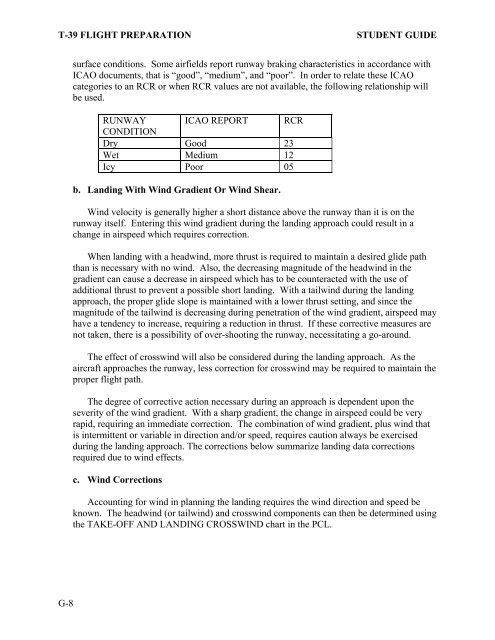t-39 - Chief of Naval Air Training
t-39 - Chief of Naval Air Training
t-39 - Chief of Naval Air Training
Create successful ePaper yourself
Turn your PDF publications into a flip-book with our unique Google optimized e-Paper software.
T-<strong>39</strong> FLIGHT PREPARATION STUDENT GUIDE<br />
G-8<br />
surface conditions. Some airfields report runway braking characteristics in accordance with<br />
ICAO documents, that is “good”, “medium”, and “poor”. In order to relate these ICAO<br />
categories to an RCR or when RCR values are not available, the following relationship will<br />
be used.<br />
RUNWAY<br />
CONDITION<br />
ICAO REPORT RCR<br />
Dry Good 23<br />
Wet Medium 12<br />
Icy Poor 05<br />
b. Landing With Wind Gradient Or Wind Shear.<br />
Wind velocity is generally higher a short distance above the runway than it is on the<br />
runway itself. Entering this wind gradient during the landing approach could result in a<br />
change in airspeed which requires correction.<br />
When landing with a headwind, more thrust is required to maintain a desired glide path<br />
than is necessary with no wind. Also, the decreasing magnitude <strong>of</strong> the headwind in the<br />
gradient can cause a decrease in airspeed which has to be counteracted with the use <strong>of</strong><br />
additional thrust to prevent a possible short landing. With a tailwind during the landing<br />
approach, the proper glide slope is maintained with a lower thrust setting, and since the<br />
magnitude <strong>of</strong> the tailwind is decreasing during penetration <strong>of</strong> the wind gradient, airspeed may<br />
have a tendency to increase, requiring a reduction in thrust. If these corrective measures are<br />
not taken, there is a possibility <strong>of</strong> over-shooting the runway, necessitating a go-around.<br />
The effect <strong>of</strong> crosswind will also be considered during the landing approach. As the<br />
aircraft approaches the runway, less correction for crosswind may be required to maintain the<br />
proper flight path.<br />
The degree <strong>of</strong> corrective action necessary during an approach is dependent upon the<br />
severity <strong>of</strong> the wind gradient. With a sharp gradient, the change in airspeed could be very<br />
rapid, requiring an immediate correction. The combination <strong>of</strong> wind gradient, plus wind that<br />
is intermittent or variable in direction and/or speed, requires caution always be exercised<br />
during the landing approach. The corrections below summarize landing data corrections<br />
required due to wind effects.<br />
c. Wind Corrections<br />
Accounting for wind in planning the landing requires the wind direction and speed be<br />
known. The headwind (or tailwind) and crosswind components can then be determined using<br />
the TAKE-OFF AND LANDING CROSSWIND chart in the PCL.
















